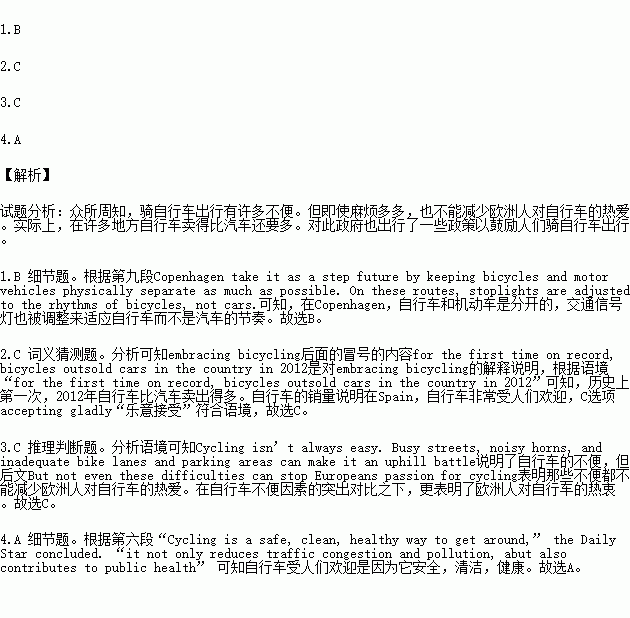题目内容
Europe loves bicycle
Cycling isn’t always easy. Busy streets, noisy horns, and inadequate bike lanes and parking areas can make it an uphill battle. But not even these difficulties can stop Europeans passion for cycling. According to BBC,bicycles outsold cars in 26 of the European Union’s 28 states last year.
In some European countries just like Denmark and the Netherlands, people really love bicycles.
But BBC reported that Spain is also embracing bicycling: for the first time on record, bicycles outsold cars in the country in 2012.
And it’s becoming a continent-wide phenomenon. “people ride to work and take their bikes to the grocery
store,” Bill Strickland, executive editor of Bicycling magazine, told Reuters.
So what has led to cycling’s growing popularity in Europe?
“Cycling is a safe, clean, healthy way to get around,” the Daily Star concluded. “it not only reduces traffic congestion and pollution, abut also contributes to public health.”
Bike-friendly policies have also contributed to the phenomenon.
Dozens of cities have joined a European Union initiative(倡议) to make bicycles on the par with (与......平分秋色) cars as a form of urban transport. Quite a few cities such as Stockholm, London, Florence and Munich now offer extensive networks of well-marked bike lanes.
Copenhagen take it as a step future by keeping bicycles and motor vehicles physically separate as much as possible. On these routes, stoplights are adjusted to the rhythms of bicycles, not cars. And the routs are lined with bicycle pump stations that are designed to the Daily Star.
For people living far from city centers, getting to work by bicycles alone may not be time-efficient. That’s why many European countries now allow cyclists to bring their bicycles onto subway trains.
Europeans are also creative in solving parking problems. The Daily Star reported that Amsterdam has come up with a high-tech solution: you lock your bike to a rack (架子), which then revolves underground. When you want your bike back, the rack rotates (旋转) it back to the surface.
1.Which of the following statements is TRUE according to the article?
A. In Denmark, all bike lanes are separated from motorized traffic.
B. In Copenhagen, cyclists are given priority (优先) over drivers in many traffic situations.
C. Bicycles are not allowed to be taken onto subway trains in most European countries.
D. Amsterdam’s cycling network and underground parking system is the most advanced in the world.
2.The underlined word “embracing” in Para3 is closest in the meaning to _____.
A. getting worries about
B. taking little interest in
C. accepting gladly
D. including as a part of something larger
3.What’s the purpose of the underlined sentence?
A. It shows the popularity of bicycles.
B. It shows why people dislike bicycles.
C. It serves as an introduction of why Europeans like bicycles.
D. It serves as a warning of difficulty in riding a bicycle.
4.More and more Europeans prefer bicycles because ________.
A. They think cycling is a safe, clean, healthy, inexpensive way to get around.
B. Cars are usually caught in traffic jams.
C. Governments require them to do so.
D. It is convenient to park their bicycles.

